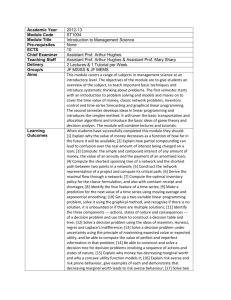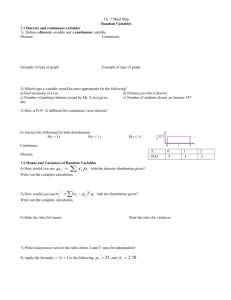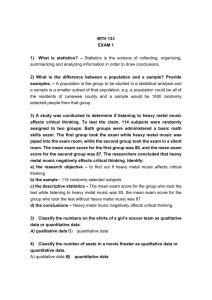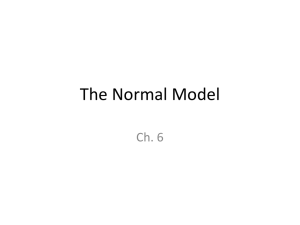TA Review 2 (2003)
advertisement
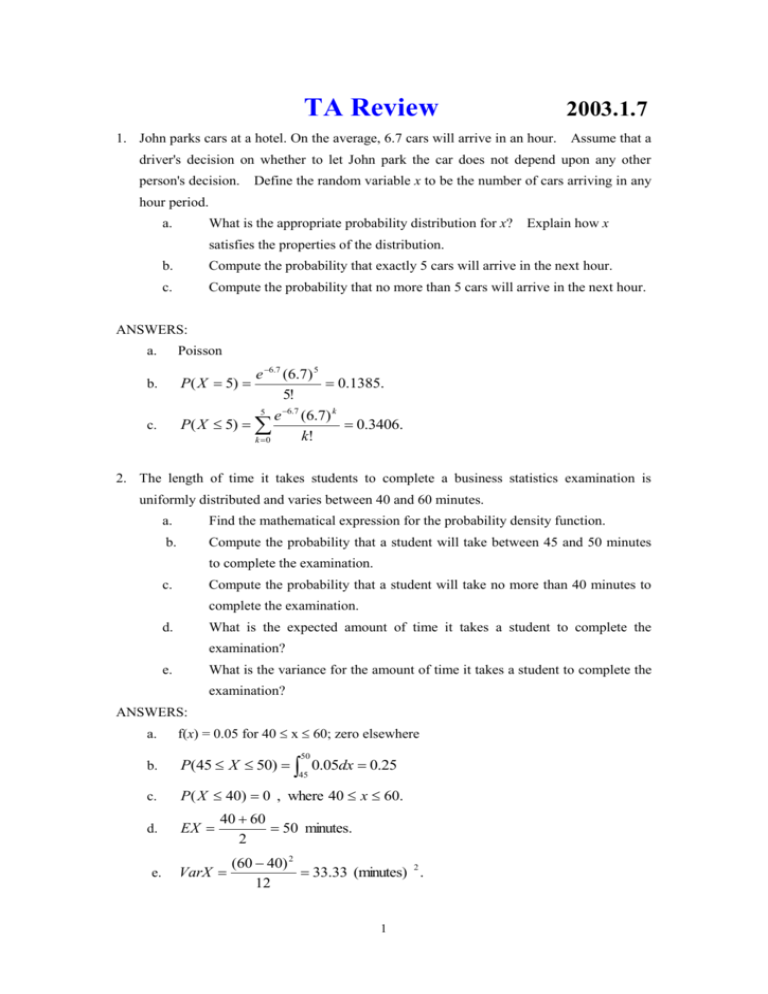
TA Review 2003.1.7 1. John parks cars at a hotel. On the average, 6.7 cars will arrive in an hour. Assume that a driver's decision on whether to let John park the car does not depend upon any other person's decision. Define the random variable x to be the number of cars arriving in any hour period. a. What is the appropriate probability distribution for x? Explain how x satisfies the properties of the distribution. b. Compute the probability that exactly 5 cars will arrive in the next hour. c. Compute the probability that no more than 5 cars will arrive in the next hour. ANSWERS: a. Poisson b. e 6.7 (6.7) 5 P( X 5) 0.1385. 5! c. P( X 5) e 6.7 (6.7) k 0.3406. k! k 0 5 2. The length of time it takes students to complete a business statistics examination is uniformly distributed and varies between 40 and 60 minutes. a. Find the mathematical expression for the probability density function. b. Compute the probability that a student will take between 45 and 50 minutes to complete the examination. c. Compute the probability that a student will take no more than 40 minutes to complete the examination. d. What is the expected amount of time it takes a student to complete the examination? e. What is the variance for the amount of time it takes a student to complete the examination? ANSWERS: a. f(x) = 0.05 for 40 x 60; zero elsewhere b. P(45 X 50) 0.05dx 0.25 c. P( X 40) 0 , where 40 x 60. d. EX e. 50 45 40 60 50 minutes. 2 VarX (60 40) 2 33.33 (minutes) 2 . 12 1 3. The time it takes a mechanic to change the oil in a car is exponentially distributed with a mean of 5 minutes. a. What is the probability density function for the time it takes to change the oil? b. What is the probability that it will take a mechanic less than 6 minutes to change the oil? c. What is the probability that it will take a mechanic between 3 and 5 minutes to change the oil? ANSWERS: for x 0 f(x) =(1/5) e-x/5 a. P( X 6) b. 6 0 x P(3 X 5) c. 6 1 5 e dx 1 e 5 0.6988. 5 5 3 x 1 5 e dx 0.1809. 5 4. A bank has kept records of the checking balances of its customers and determined that the average daily balance of its customers is $300 with a standard deviation of $48. A random sample of 144 checking accounts is selected. a. What is the probability that the sample mean will be more than $306.60? b. What is the probability that the sample mean will be less than $308? c. What is the probability that the sample mean will be between $302 and $308? d. What is the probability that the sample mean will be at least $296? ANSWERS: P( X 306.600) 1 ( a. 6.60 ) 0.0495. 4 c. 8 P( X 308) ( ) 0.9772. 4 P(302 X 308) (2) (0.50) 0.2857. d. P( X 296) 1 (1) (1.00) 0.8413. b. 5. The average lifetime of a light bulb is 3,000 hours with a standard deviation of 696 hours. A simple random sample of 36 bulbs is taken. a. What are the expected value, standard deviation, and shape of the sampling a. c. distribution of x ? What is the random variable in this problem? Define it in words. What is the probability that the average life in the sample will be between 2,670.56 and 2,809.76 hours? 2 d. What is the probability that the average life in the sample will be greater than 3,219.24 hours? e. What is the probability that the average life in the sample will be less than 3,180.96 hours? ANSWERS: a. 3,000; s n 696 36 116 ; normal. b. c. x the average life in a sample of 36 bulbs P(2670.56 X 2809.76) (1 (1.64)) (1 (2.84)) 0.0482. d. P( X 3219.24) 1 (1.89) 0.0294. e. P( X 3180.96) (1.56) 0.9406. 6. A random sample of ten examination papers in a course that was given on a pass or fail basis showed the following scores. Paper Number GradeStatus 1 65 Pass 2 87 Pass 3 92 Pass 4 35 Fail 5 79 Pass 6 100 Pass 7 48 Fail 8 74 Pass 9 79 Pass 10 91 Pass a. What is the point estimate for the mean of the population? b. What is the point estimate for the standard deviation of the population? c. What is the point estimate for the proportion of all students who passed the course? ANSWERS: a. x b. s c. 65 87 91 75. 10 (65 75) 2 (87 75) 2 (91 75) 2 20.48. 10 1 8 P( all students who passed the course ) 0.8. 10 3

